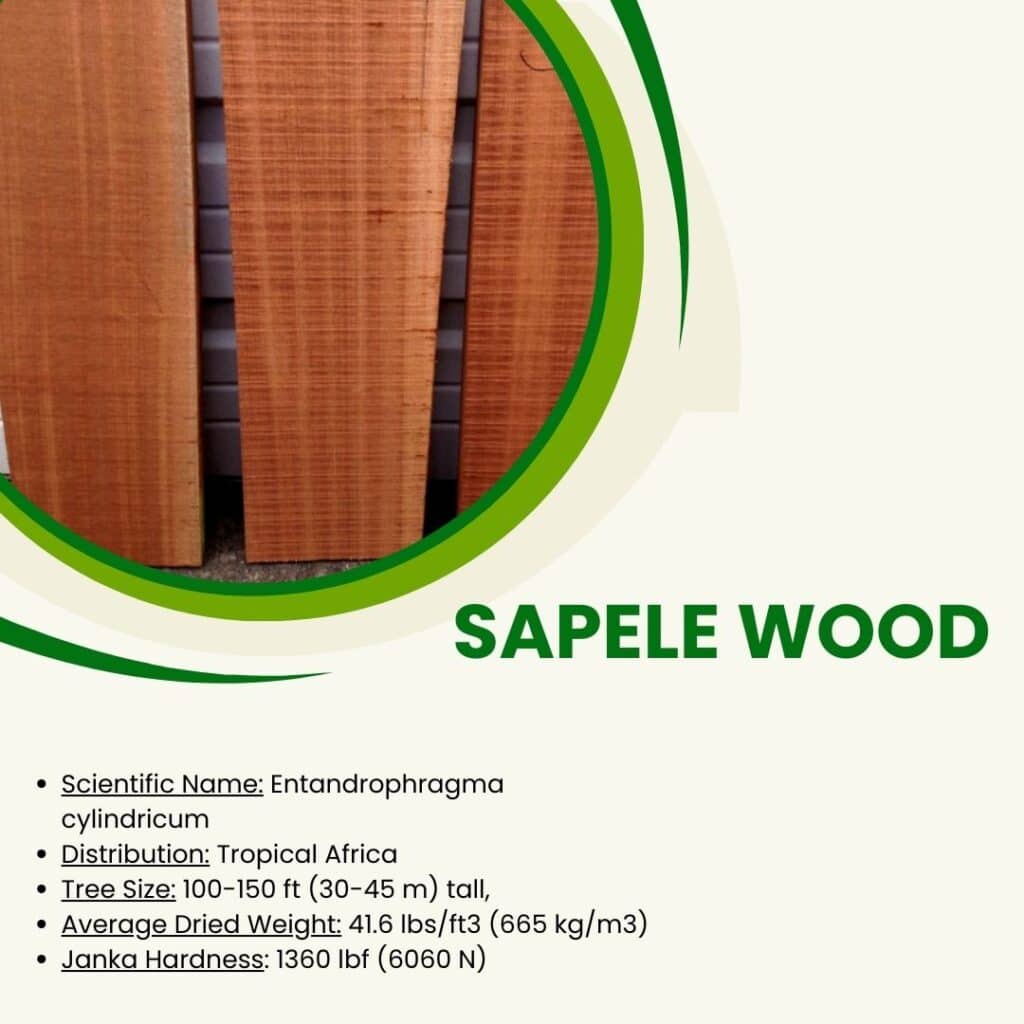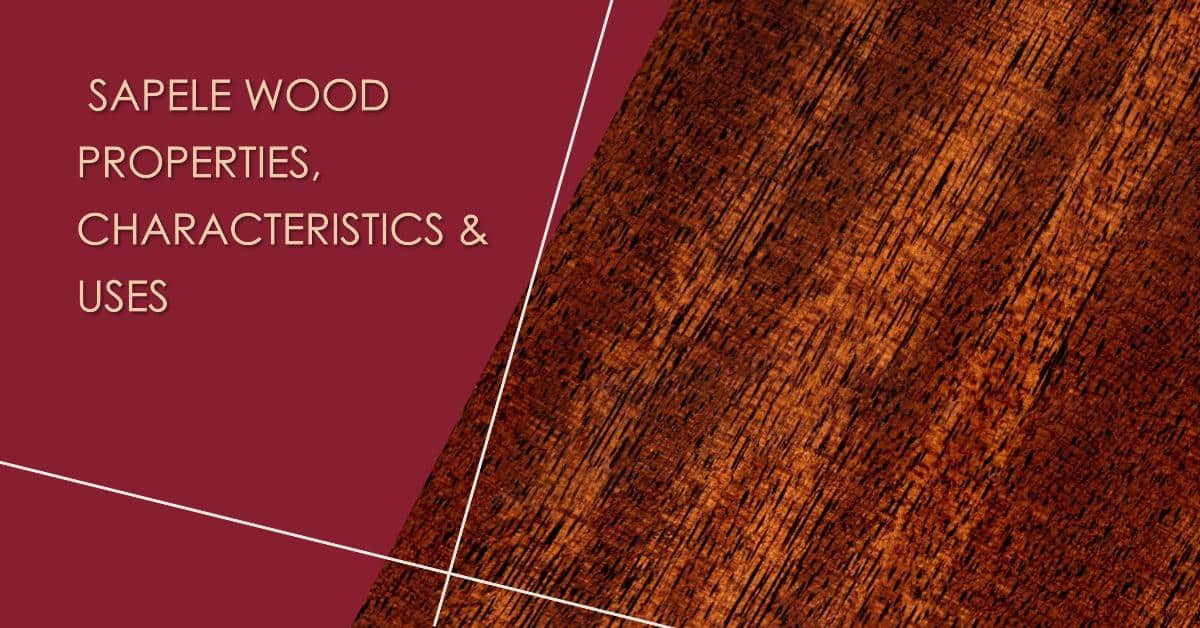Sapele wood in Africa’s lush rainforests offers a compelling alternative to traditional mahogany. Often less expensive than various types of mahogany wood but shares some similar properties, it is renowned for its stunning reddish-brown hue and remarkable durability. In this comprehensive guide, Timber Explore will help you understand the different properties of Sapele wood in detail.
So let’s get started.
About Sapele Wood
Sapele, also known as Sapelli or Sapeli, is a tropical hardwood sourced primarily from the lush forests of Africa. Scientifically classified as Entandrophragma cylindricum, it earns its name from Sapele City in Nigeria, where the tree thrives abundantly.
These majestic trees can tower up to 100-150 feet (30-45 meters) tall, boasting trunk diameters of 3-5 feet (1-1.5 meters). With an average dried weight of about 670 kg/m3, Sapele wood is notably heavy and dense. Its remarkable hardness is reflected in its impressive Janka rating of 1,410 lbf, making it exceptionally sturdy and durable. Moreover, Sapele timber is a prized choice for various woodworking projects. From furniture and cabinetry to flooring and musical instruments, Sapele’s beauty and strength make it a versatile and sought-after material among craftsmen and designers worldwide.
Common Properties of Sapele Wood

| Property | Value |
|---|---|
| Common Name(s) | Sapele, sapelli, sapeli mahogany |
| Scientific Name | Entandrophragma cylindricum |
| Distribution | Tropical Africa |
| Tree Size | 100-150 ft tall, 3-5 ft trunk diameter |
| Average Dried Weight | 41.6 lbs/ft3 (665 kg/m3) |
| Specific Gravity (Basic, 12% MC) | 0.56, 0.67 |
| Janka Hardness | 1360 lbf (6060 N) |
| Modulus of Rupture | 16070 lbf/in2 (110.9 MPa) |
| Elastic Modulus | 1790000 lbf/in2 (12.35 GPa) |
| Crushing Strength | 8540 lbf/in2 (58.9 MPa) |
| Shrinkage | Radial: 5.2%, Tangential: 7.2%, Volumetric: 12.9%, T/R Ratio: 1.4 |
Color and Grain Pattern
Sapele wood has a rich reddish-brown color with darker streaks, getting darker as it ages. Its grain patterns include ribbon-like stripes and other fancy designs like pommele and quilted. The grain is tangled and sometimes wavy, giving it a smooth texture and natural shine.
Density and Hardness
It is moderately dense and ranks high on the Janka hardness scale, making it highly resistant to wear, denting, and decay.
Workability
Working with Sapele can be tricky in certain machining tasks like planing and routing because of its interlocked grain, which can cause tear out. Additionally, it may become discolored and stained if it comes into direct contact with iron. However, despite these challenges, its overall workability remains favorable for various woodworking projects.
Stability
It exhibits excellent dimensional stability, meaning it is less prone to warping, twisting, or shrinking due to changes in humidity and temperature. This stability makes it ideal for applications where consistent dimensions are crucial, such as furniture making & cabinetry.
Finishing
It responds exceptionally well to various finishes, including stains, oils, and clear coats. Its fine texture and lustrous appearance make it a favorite choice for projects where a polished, refined look is desired.
Versatility
One of the most notable characteristics of Sapele wood is its versatility. From fine furniture and musical instruments to exterior trim and architectural millwork, it finds its way into a diverse range of applications, thanks to its strength, stability, and aesthetic appeal.
Advantages and Disadvantages of Sapele Lumber
- Beautiful Appearance:
- Sapele has an attractive golden to dark reddish-brown color with a distinctive ribbon-like stripe pattern, enhancing its visual appeal.
- Extremely Durable:
- It is hard and dense, making it durable and stable for indoor & outdoor applications.
- Regular maintenance, such as polishing and painting, can further enhance its longevity
- Easy Maintenance:
- Sapele is low maintenance and affordable.
- Despite being harder than African mahogany, it can be easily cut and bent, making it suitable for various woodworking projects
- Challenging Workability:
- Due to its density and interlocked grain structure, working with sapele can be challenging.
- It may have a blunting effect during machining operations
Common Uses of Sapele Lumber
- Furniture: Used in tables, chairs, cabinets, or bed frames.
- Musical Instruments: Guitars, violins, and pianos.
- Architectural Millwork: An ideal choice for adding decorative elements to residential & commercial buildings.
- Exterior Applications: Well-suited for outdoor applications such as decking, siding, and boat building.
- Interior Finishes: From flooring and paneling to staircases and built-in shelving.

